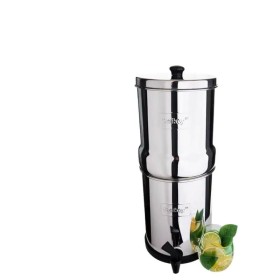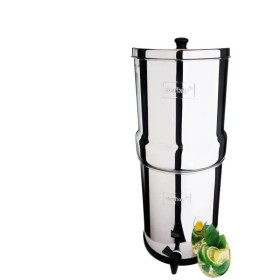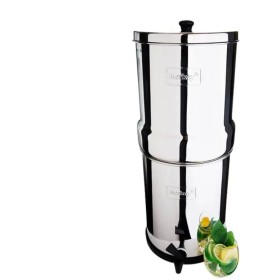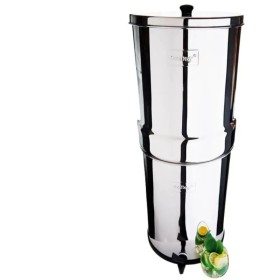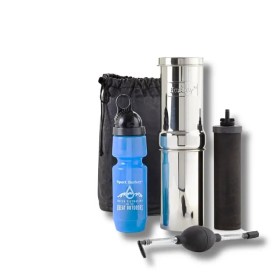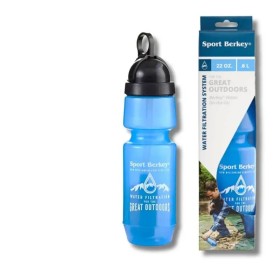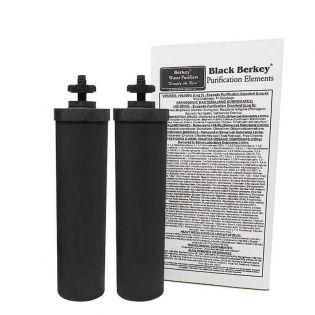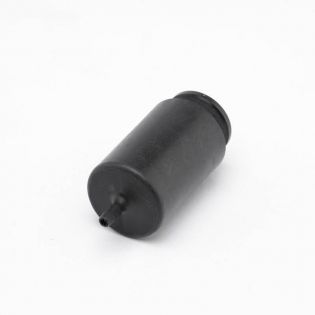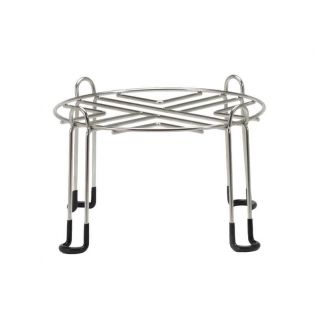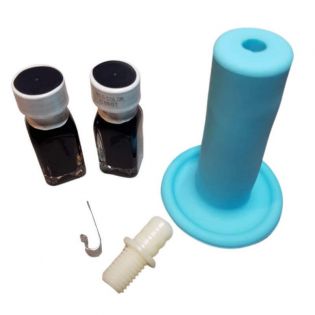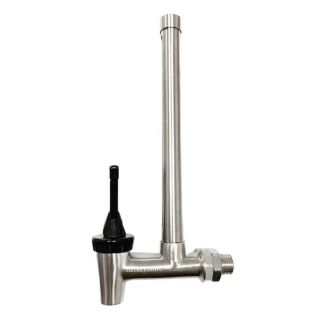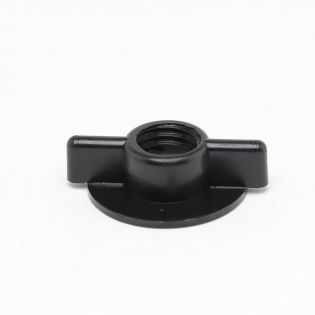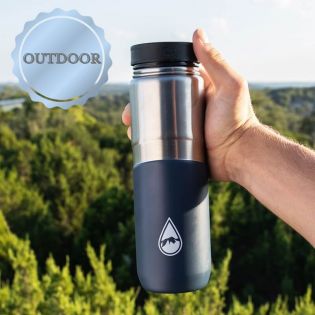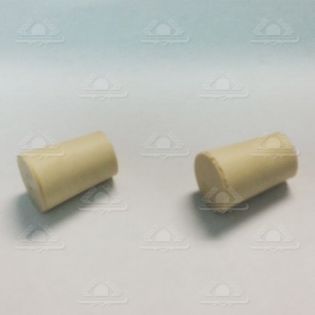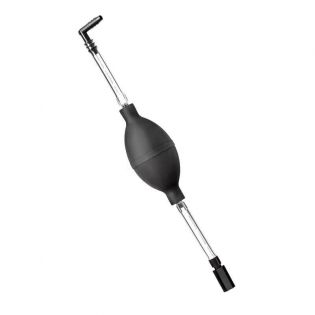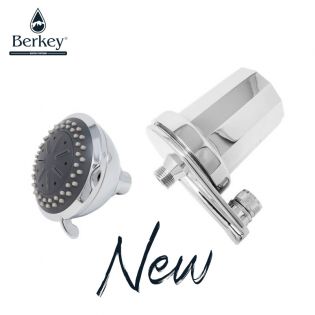Use and maintenance of Berkey® water purifiers
See the assembly document for a diagram and specific instructions on how to assemble your Berkey® stainless steel water purifier.
This document also contains instructions for placing the filter elements.
For more details, you can consult the specific Black Berkey® element priming document.
Black Berkey® water filters are so effective they can remove red food coloring from water. This is a foolproof way to test your system and make sure it's working properly.
The purpose of this test is to confirm that the system has been assembled as intended and that there are no internal leaks in your system. We recommend performing this test after the first assembly of our systems, after the removal or replacement of Black Berkey® components, or when using the system for the first time after drying and storing the components for an extended period.
The staining test is designed only for Black Berkey® purification elements. It should not be done for the Berkey® Sport Bottle Filter or the PF-2 filters.
The food coloring must be RED and LIQUID. Red food coloring (unlike other colorings) does not contain minerals, so your filter will consider it a contaminant and filter it out.
You can find this food coloring in small bottles in specialty stores or hobby and craft stores. You must choose a liquid colorant and not a gel, and check its composition: it must not contain any sugar, glucose or thickener. The dye must not be E120 Carmine (cochineal) or E162 Betanin (beet).
You must therefore check that the dye used contains either E122 (Crimson), E123 (Amaranth), E124 (Ponceau), E127 (Erythrosine), E129 (Allura Red) or E180 (Ruby).
The red food color test should be performed after priming your Black Berkey® purification elements and WITHOUT THE PF-2™ FILTERS.
TO RUN THE TEST:
- Start with an empty system (upper and lower chambers) and remove all Berkey PF-2™ fluoride and arsenic reduction filters (if installed). If they remain in place, the warranty on these filters will no longer be valid.
- Take only the top chamber (with the Black Berkey® elements installed) and place it on containers (glasses, cups, vases, etc.) of similar size so that there is a container under each filter. This will isolate any defective filters.
- In a separate container filled with water, add the dye in the proportions indicated below. Mix well. DO NOT pour the dye directly into the tank. Prepare a mixture of the volume indicated below:
DOSING THE COLOURING European Brand :
1/4 teaspoon (3-5 drops) of red food colouring for a Travel, Big or Royal Berkey®, or 1/2 teaspoon (5-10 drops) for an Imperial or Crown Berkey®.
DOSAGE OF MCCORMICK COLOURING recommended by Berkey® (Available on our shop) :
1/8 teaspoon (10 drops) for 4 litres of water:
- Travel Berkey® - 4 litres of water, 10 drops
- Big Berkey® - 8 litres, 20 drops
- Royal Berkey® - 8 litres, 20 drops
- Imperial Berkey® - 8 litres, 20 drops
- Crown Berkey® - 8 litres, 20 drops
- Let the water run into the containers.
If the red food coloring does not appear in any of the cups, your purification system is working properly.
If the water in any of the containers is red or has a pinkish tinge, the filter in question is defective or exhausted or the seal is not properly secured.
IF YOU FIND DYE IN ANY OF THE CONTAINERS, PLEASE CHECK THE FOLLOWING:
- Are the nuts secure? Please do not tighten them with tools. They should be tightened by hand for a perfect fit. If the nuts are too tight, it could cause the threads to deform, preventing a proper seal.
- Did you use "red food coloring"? Red food coloring is the only type recommended for this test.
- Is the washer positioned on the stem inside the upper chamber and the nut attached below? If the washer is on the outside of the chamber with the nut, you will not have a proper seal, which will cause your system to malfunction. Place the washer inside the upper chamber and retest.
- Are the locking plugs properly sealing the unused holes (without a filter element)? Are the plugs installed and tightened with a washer on each side? If the plugs leak, the test will fail. Tighten the plugs more firmly and retest.
- If you are testing an item that has already failed, flush it and prime it again.
If, despite all these precautions, you find that a filter fails the stain test, please contact us.
When you carry out the test for the second time, remember to take a video of what you did (mixing the dye, filling the high tank, filtering in independent containers). Proof must be provided in the event of a positive test and a claim.
Most people use a carafe or pitcher to pour water into the upper chamber. If you have a faucet with a hose on your sink, this can also be a good solution.
The upper chamber, which contains water only momentarily, will need to be cleaned less frequently than the inner chamber, in which water remains for a longer period of time. We recommend cleaning the lower chamber once a month.
Stainless steel chambers can be cleaned with soapy water (dishwashing liquid).
In areas with hard water, lime deposits can build up on the lugs and chambers after prolonged use. To remove it, you can use vinegar pure or in a 50-50% mixture of vinegar and water that you spray on and leave for about 15 minutes. Then wipe with a sponge, then wash with soapy water and rinse.
Yes, it is quite normal to have 2 to 3 cm of water remaining in the upper chamber. To be filtered, the water must pass through very fine micropores in the filters. The lower the water level in the upper chamber, the lower the pressure available to force the water through the micropores. You may have noticed that the filtration rate is much faster when the upper chamber is full than when it is half empty. This is because there is more pressure. The only way to remedy this problem would be to enlarge the pores of the filter elements, which would reduce the efficiency of the Berkey purification system. During each cycle, the residual water from the previous cycle mixes with the water from the current cycle and is then purified. There is no need to worry about excess water during normal use. If, however, you stop using your filter for a long time, for example during a vacation, it is best to empty both chambers and let them dry completely.
Concerning the lower chamber, the tap cannot technically be positioned on the bottom of the tank for reasons of watertightness. Don't worry, this is not stagnant water as it will mix again and again during the successive filtrations.
We recommend replacing your filtered water with your Berkey® system after three days if it has not been used. If the water is in a cold environment, the time can be extended to one week. This is a precautionary principle. The reason is that when you filter your water, the chemicals that inhibit the growth of bacteria are removed. In very humid environments, bacterial growth can occur more quickly.
It is not recommended to let your filters freeze. Similarly, it is not recommended to store the elements (even unused ones) in very cold climates. Indeed, the residual water contained inside the element will expand and consequently increase the size of the pores and eventually destroy the element. Whether your filters are unused or even used and completely dry, a small amount of moisture may remain inside, especially in predominantly humid climates. This moisture could expand inside the filter and render it unusable. Please note that this recommendation applies to ALL Berkey® items, including the Berkey® Sport Bottle. Freezing your item and rendering it unusable will also void your warranty coverage.
If you need to transport your Berkey® filtration and purification system, you must first remove the Black Berkey® purification elements. If you do not remove them from the system, you may break the rods. Place your water filters in a safe, watertight package. The stainless steel top and bottom parts fit together for easy transport and space savings. If your system has a level valve, be careful to remove or secure it so it doesn't break.
Important : Failure to remove the filter elements from the system may result in rod failure and will void the manufacturer's warranty.
This happens mainly with the use of hard (highly mineralized) water. This water is basically more alkaline and has a higher pH. Alkaline water has less potential to hold dissolved minerals in solution than more acidic water. The minerals then begin to precipitate over time and, depending on the mineral composition, will either sink to the bottom or float to the top. This process is called flocculation. This is not dangerous and is in no way a symptom of a failure in your system. The white residue is minerals that were already in your water and are now simply visible when they were previously invisible due to their suspension in ionic form.
Whether Black Berkey® filters or Berkey® PF-2™ filters, it is necessary to prime them before their first use or after a long storage time.
You can refer to the Black Berkey® water filter priming document and also the PF-2™ filter priming.
To facilitate priming Black Berkey® filters, or if space under your faucet is limited, there is also a convenient priming pump that allows you to prime Black Berkey® filters anywhere, anytime.
If the filters have not been cleaned and primed properly or if your tanks have not been thoroughly cleaned and rinsed, the water from your first filtrations may have a peculiar, even mineral taste. You can empty the first 2 or 3 filtrations.
If this persists, make sure that the black seals of the Black Berkey® filters are well positioned on the upper tank side and not above the butterfly nuts on the lower tank side.
If necessary, proceed again to a more rigorous cleaning and priming of your system.
The following answer is applicable to all models in the Berkey® line, provided that the volume calculations are adjusted.
The Big Berkey®'s advertised volume of 8.5 liters is the volume of the lower tank. This means that you can stock up to 8.5 liters of filtered water.
Explanation: The top tank is slightly smaller for safety reasons to avoid overflow if the bottom tank was not perfectly empty.
Specifically, in the case of the Big Berkey, the upper tank has a volume of 8.32 liters. In addition, the volume of the Black Berkey® filters must be taken into account. Each filter has a volume of 0.51 liter.
If your Big Berkey is equipped with 2 filters, you can fill a maximum of 7.3 liters of water.
In practice, you will fill a little less than that because there is always about 2 cm of water left at the bottom of the tank (see explanations here).
You should also know that when the bottom tank has been emptied, there is also water left at the bottom, about 1 liter (see previous link).
The volume of water that you fill at the top has therefore been perfectly thought out and calculated by the manufacturer and allows, in current use, to have a reserve of 8.5 liters of filtered water in the lower tank, while avoiding the risk of overflowing.
Tip: if you want to empty the lower tank completely into a carafe, you can tilt your Berkey® forward by grasping the lid button.
This occurs in rare cases. This may be due to an air lock between the upper and lower chambers. If there is not enough air between the two chambers, the water will not flow out of the tap.
The first thing to check is the presence of water at the junction of the tanks, due to a filling whose level has risen too high (once can be enough!). You must then wipe the perimeter of the bottom of the upper tank and the inside of the top of the lower tank, and be careful with the next fillings.
If your system was delivered with the metal clip contained in the starter pack, install it between the two tanks and the problem will be solved.
Check the elements contained in the faucet bag: 1 faucet, 1 nut, 2 gaskets (2 flat or 1 flat and 1 beveled).
See if the leak is coming from the spout (where the water is supposed to come out) or from where the faucet meets the stainless steel bowl.
- If the leak is from the spout, tighten the round base under the lever clockwise.
- If the leak is at the sealing area, make sure the washers are properly installed. If this is the case, tighten the valve nut with a wrench (mm by mm). Before tightening, make sure that all surfaces are completely dry so that the seals do not slip when tightening.
- If none of these solutions work, contact customer service.

